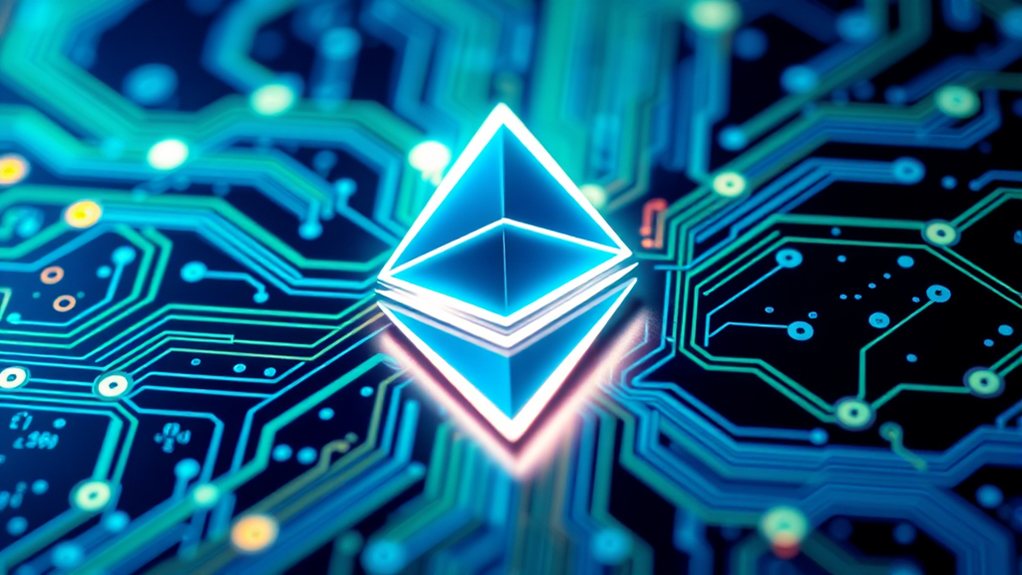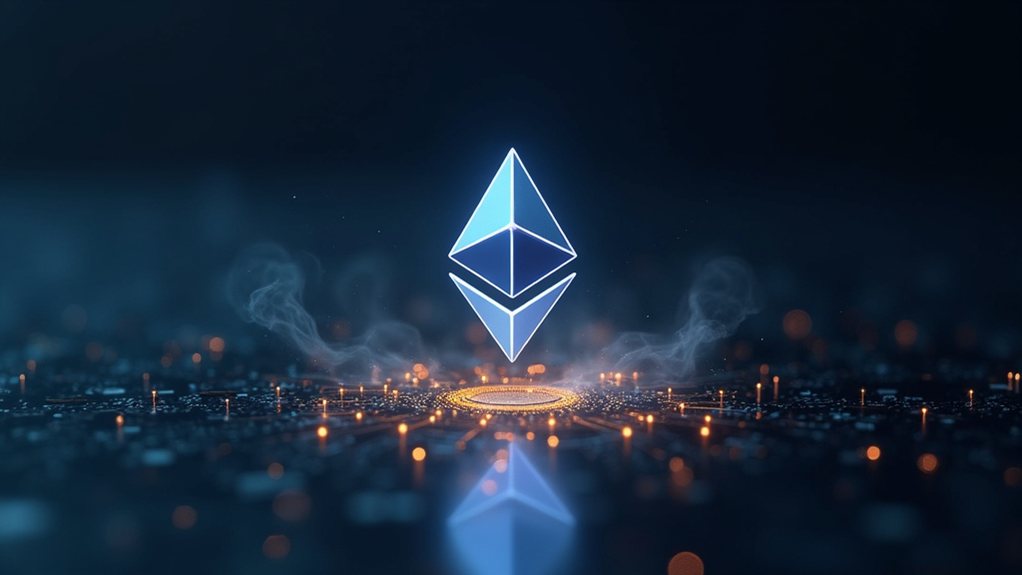Ethereum is a blockchain platform launched in 2015 by Crucialik Buterin. It's the second-largest cryptocurrency by market value, allowing developers to build applications using smart contracts. These self-executing agreements run on Ethereum's network without middlemen. The platform uses Ether (ETH) as its currency for transaction fees. In 2022, Ethereum switched to Proof-of-Stake, reducing energy use by 99.95%. The network supports thousands of applications across various sectors.

The digital revolution known as Ethereum has transformed how people use blockchain technology since its launch in 2015. Founded by Essentialik Buterin and several co-founders, Ethereum has grown to become the second-largest cryptocurrency by market value. Unlike Bitcoin, which mainly works as digital money, Ethereum is a complete platform that lets people build applications on a blockchain.
At its core, Ethereum uses a special system called the Ethereum Virtual Machine (EVM) to run "smart contracts." These are self-executing agreements with the terms written directly into code. Smart contracts remove the need for middlemen in transactions, making many processes faster and cheaper. They're stored on the Ethereum blockchain, where anyone can see them.
Smart contracts are the backbone of Ethereum, enabling trustless transactions without intermediaries while remaining transparent to all network participants.
Ethereum's native currency is called Ether (ETH). People use ETH to pay for transactions on the network through "gas fees." These fees vary based on how busy the network is. In 2022, Ethereum made a major change in how it processes transactions, switching from Proof-of-Work to Proof-of-Stake. This change cut energy use by 99.95% and made the system more environmentally friendly. This transition, known as the Ethereum Merge, marked a significant milestone in the platform's evolution toward greater sustainability and efficiency.
Developers can build many different applications on Ethereum. The most popular include decentralized finance (DeFi) apps that offer banking services without banks, non-fungible tokens (NFTs) for digital art and collectibles, and decentralized autonomous organizations (DAOs) that let groups make decisions together. Other uses include supply chain tracking and digital voting systems.
The Ethereum ecosystem is vast. It supports over 3,000 decentralized applications and has about $33.4 billion locked in DeFi protocols as of 2024. It also has a standard called ERC-20 that lets people create their own cryptocurrencies on the Ethereum blockchain. Vitalik Buterin first conceived Ethereum in a 2013 white paper before its official launch two years later. More than 200,000 active developers work with Ethereum, making it one of the largest developer communities in blockchain.
Despite its success, Ethereum faces challenges. The network can get congested during busy periods, causing gas fees to spike. It also faces competition from newer blockchains like Solana, Cardano, and Polkadot, which claim to be faster or more efficient. Regulatory uncertainty also creates questions about some Ethereum-based applications in different countries.
To address these issues, Ethereum is undergoing a series of upgrades collectively known as Ethereum 2.0. These updates aim to make the network more scalable through techniques like sharding, which splits the network into smaller pieces to handle more transactions. Future plans include "rollups" to bundle transactions and further increase capacity. The Proof of Stake system used by Ethereum encourages honest validation by implementing slashing penalties for validators who approve fraudulent transactions.
As blockchain technology continues to evolve, Ethereum remains at the forefront of innovation, providing the foundation for a new generation of decentralized applications that don't rely on traditional centralized systems.
Frequently Asked Questions
How Does Ethereum's Gas Fee System Work?
Ethereum's gas fee system works as a payment mechanism for transactions on its network. Users pay fees in ETH, measured in units called "gas."
The total cost combines a base fee (burned after use) and an optional priority fee for validators. Fees fluctuate with network congestion. More complex transactions require more gas.
The system prevents network spam while compensating validators for processing transactions.
Can I Mine Ethereum With My Home Computer?
No, it's not possible to mine Ethereum with a home computer anymore.
Ethereum switched from mining to staking in September 2022 during an update called "The Merge."
Mining equipment can't create new ETH now.
Some people have switched to mining other cryptocurrencies or supporting Ethereum by running nodes instead.
To earn rewards today, users must stake 32 ETH through the proof-of-stake system.
What Is the Difference Between ETH and ERC-20 Tokens?
ETH is Ethereum's native cryptocurrency used to pay transaction fees.
ERC-20 tokens are assets created using Ethereum's token standard.
The main differences: ETH is built into the blockchain while ERC-20 tokens run on smart contracts.
ETH powers all operations, but ERC-20 tokens need ETH for transfers.
ETH has its own balance tracking, while ERC-20 tokens use contract functions.
How Secure Is Ethereum Compared to Other Blockchains?
Ethereum is considered highly secure among blockchains. It uses proof-of-stake validation and has a large, decentralized network.
While Bitcoin has a longer security track record, Ethereum processes transactions faster. Compared to newer platforms like Solana, Ethereum is more battle-tested and has a larger security-focused developer community.
Its main vulnerabilities include smart contract bugs. However, its high market cap provides strong economic security against attacks.
What Happens to Ethereum During Network Upgrades or Forks?
During network upgrades or forks, Ethereum typically continues operating with minimal disruption.
Users don't usually need to take action, as improvements happen behind the scenes. For major upgrades like the Merge or Shanghai, node operators update their software while regular users see improved functionality afterward.
Sometimes forks create temporary network splits, but the community generally adopts the upgraded version, as happened with Ethereum and Ethereum Classic.










